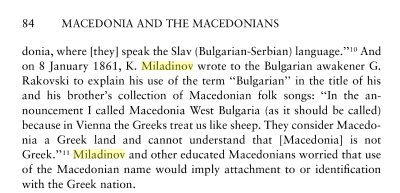My family doesn't use Lepa for 'beautiful', except on some very rare occasions, but I know others from Bitola that do, and I also know a lady called Lepa, so I doubt it is a borrowing from elsewhere, just a word that has largely fallen out of use in many parts. Having said that, in my dialect it is almost exclusively Uba for 'beautiful', so instead of Mnogu ubava e we would say Nogu uba e.
In the Miladinov texts, both variants are used, and apart from the few obvious Turkisms that were dropped as the Ottoman era disappeared, the below text is easily identifiable as Macedonian.

Momchitse belo! dali bi me zelo?
Zelo bi te zelo, maika ne me davat,
Zashto kukya nemash, kukya chardakliya,
Kukya chardakliya s dzhamoi i pendzheri.
Momchitse milo! beli pari imam,
Kukya ke napra'am s dzhamoi i pendzheri.
The Macedonian dialect used in the Abecedar from the 1920's, which is 60 years after the Miladinov period, differs little from the above.

Here is the equivalent in literary Macedonian, just to highlight how close the dialects are and how insignificant most variations are.
Site lugye imaat edna glava, dve race, dve nodze.
Glavata gore ima kosa, i napred ima dve ochi, eden nos i edna usta.
Ustata vnatre ima zabi i eden yazik.
Zabite se beli, yazikot e tsrven.
So ustata yadime, pieme i zboruvame.
So ratsete rabotime, so nodzete odime, trchame i ripame.
Yas trcham brzo i ripam mnogu visoko.
Our language exists as a natural evolution of the native tongue in Macedonia.
In the Miladinov texts, both variants are used, and apart from the few obvious Turkisms that were dropped as the Ottoman era disappeared, the below text is easily identifiable as Macedonian.

Momchitse belo! dali bi me zelo?
Zelo bi te zelo, maika ne me davat,
Zashto kukya nemash, kukya chardakliya,
Kukya chardakliya s dzhamoi i pendzheri.
Momchitse milo! beli pari imam,
Kukya ke napra'am s dzhamoi i pendzheri.
The Macedonian dialect used in the Abecedar from the 1920's, which is 60 years after the Miladinov period, differs little from the above.

Here is the equivalent in literary Macedonian, just to highlight how close the dialects are and how insignificant most variations are.
Site lugye imaat edna glava, dve race, dve nodze.
Glavata gore ima kosa, i napred ima dve ochi, eden nos i edna usta.
Ustata vnatre ima zabi i eden yazik.
Zabite se beli, yazikot e tsrven.
So ustata yadime, pieme i zboruvame.
So ratsete rabotime, so nodzete odime, trchame i ripame.
Yas trcham brzo i ripam mnogu visoko.
Our language exists as a natural evolution of the native tongue in Macedonia.



Comment